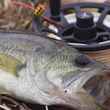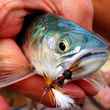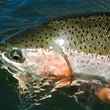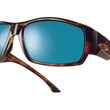It’s one thing when a rod manufacturer claims to have crafted the best rod for any particular scenario—as I’ve noted before, rod-makers are happy to oblige in building rods for any niche.
It’s quite another thing when said rod does exactly what the manufacturer says it will do.
Built for seasoned anglers who throw heavy line armed with heavy streamers to (hopefully) heavy fish, anglers who need to fish at long distances or those that fish in challenging (read: windy) conditions, Sage’s new IGNITER seems to check all the boxes. Incorporating Sage’s lighter, denser KonneticHD technology—which debuted in the X and has since found its way into rods throughout Sage’s lineup—the rod heaves line accurately without much fuss, and it throws sinking or sink-tip line as if it is meant to do just that.
It’s a specialized rod; it’s not a tool most fly fishers would need (or, frankly, want) as a go-to rod for general angling. It is built for a niche—a big niche, no doubt, but a niche nonetheless.
What works
The tech
Sage touts its new KonneticHD technology for allowing them to craft a rod blank that’s dense and powerful, yet light and responsive. It’s a goal that most high-end rod manufacturers are pursuing: faster, lighter, stronger.
We can gush about science we only partially understand, like the proprietary graphite/resin composite Sage is using in its new rods. We can talk about the “amplified strength-to-weight and stiffness-to-weight ratios as needed within the rod blank,” or the “highest energy transferring material [Sage has] ever created.” But most companies make similar claims about their technology and its advantages, and none of them really matter unless they can be verified by anglers on the water.
High-end fly rods aren’t cheap, and while you may be holding a sweet stick in your hands with the IGNITER, it’s not really the rod you’re paying $900 for, but the research and the development the company has put into it.
In Sage’s case, the touted advantages of KonnecticHD in the IGNITER ring true. The IGNITER handles all the heavy gear you could throw at it, and it fishes very well in circumstances where other rods might fall short. It’s fast (not broom-handle fast, but fast). It’s strong. But it’s also light. And it delivers flies with zero line slap and virtually no rod wiggle.
The fishing
I took the IGNITER to the bull trout waters of southern Alberta, and threw big, weighted streamers into impossibly deep runs using sink-tip lines. The 7-weight IGNITER I used didn’t complain a bit at the weight from the line or the streamer, and when a big fish finally did come calling, the IGNITER handled itself remarkably well. Bull trout tend to have softer mouths, so a tough set can pull flies free. Despite its speed and its impressive backbone, the rod handled a softer strike-set just fine, and it was just supple enough to let me know I was battling 28 inches of wild char.
Longer casts
Once I dialed in the rod speed and the line speed the IGNITER is capable of generating, I noticed that I was much more comfortable with longer casts, threw tighter, smoother loops and that I was hitting my target more often than not. In my mind, that’s a credit to the rod’s backbone and recovery ability.
Stiff and strong
When ditching the sink-tip line and going with a full-floating line armed with lighter flies in shallower water, the rod’s tip flex allowed me to lift and recast quickly without having to throw in a false cast. More than once, when big bulls moved from under cut banks to attack a streamer, I missed the fish on the first try, but was able to put the fly back in the strike zone quickly. A couple of times, I was able to reconnect with big char that I missed on the first go-round.
That’s a feature, I think, that saltwater anglers will appreciate—the ability to lift line from the water and quickly recast with no need for a false cast or two. When chasing bonefish or permit, this isn’t a luxury, but a requirement—the IGNITER, as advertised, simply makes these casts easier.
Slim and light
It’s slim. I put it up next to a 6-weight I was using to cast dry flies to big cutthroats in heavy water, and the IGNITER—a full line weight heavier—has a noticeably thinner profile, and it was measurably lighter.

The look
For the price point, it better be gorgeous, right? And it is.
The “chipotle” blank is a sweet maroon color, and the hardware, from the hidden hook-keeper in the reel seat to the Fuji ceramic stripping guides and the chromed snake guides and tip-top are all high-end. Even the aluminum rod case embossed with the Sage medallion is pretty classy.
What doesn’t
Break in required
No, you won’t need to break in the IGNITER like you did your last pair of hiking boots did. But, just like you took those boots out for a few trial runs before heading 12 miles into Yellowstone’s backcountry with them, you’ll likely be well served by spending some time with your new IGNITER before you throw flies at fish with it.
I think what I struggled with more than anything else was the rod’s ability to generate serious line speed. When I first started fishing it, I was actually outcasting my target. More than once, I overshot my intended target and dropped a massive streamer into the willows or on the rocks beyond the pool I was aiming for.
While that might be just swell for my ego, it’s proof that, before you take this rod to the flats and cold-cast it to a cruising bonefish, you better know what to expect. It may seem disingenuous to complain about casting too far, but when you have one shot at a cruiser and you line the fish instead of putting the fly where you think it should go, that’s on you for not getting to know your rod before you take it fishing.
Is too much line speed a fault? Not really—at least not on the part of the rod. If there’s a fault, it’s that, as I mentioned, the rod takes some time to get used to. Once you’ve become accustomed to its speed, you’ll be able to tap into the things that likely drew you the IGNITER—more distance, more torsional stability under load, the ability to quickly pick up line, etc.
Not for everyone, so know you need it
Say you’re in the market for a new rod for your favorite type of fishing—casting to rainbows gracefully sipping blue-winged olives on the Henry’s Fork—and the shop you’re in pushes the IGNITER on you ... walk out.
Does that mean you can’t fish the IGNITER to those sipping rainbows? Of course not. But why the hell would you want to? The IGNITER isn’t built for that. Rather, it’s built for specific fishing scenarios where other rods leave the angler wanting. Whether that want is more distance, more graceful handling of heavy rigs, better wind-cutting power or something else, chances are, if you’re one of those anglers, you’ll know it.
Put simply, the IGNITER isn’t built for the casual caster, or the twice-a-summer fly fisher who sneaks away from camp while the family is napping for an afternoon. I like how Sage actually owns that message.
Final word
The IGNITER is the fruit of Sage’s labor to continually improve the technology in the rods it builds. The latest of Sage’s graphite and resin advancements, KonnecticHD, has allowed Sage the ability to build a rod that’s stronger and lighter—a rod constructed for technical situations, extreme weather and situations where long casts are vital.
Sage bills the IGNITER as “not a rod for the everyday angler," but I'd beg to differ. The IGNITER might not be for the casual angler that isn't fishing in scenarios that require a purpose-driven, application-specific rod like the IGNITER. But, if I spent my angling days chasing sea-run browns in Tierra del Fuego, fishing bulky rigs to redsides on the wind-whipped Deschutes, stalking permit on Belizean flats or dumping long T-14 tips into swift runs hoping to swing up a Skeena steelhead, I'd more than happily fish the IGNITER everyday. Yes, indeed. Every. Single. One.































Comments
Nick Radisic replied on Permalink
While I agree with most of your assessment of the Sage Igniter rod and its amazing capabilities, I'd like to add some comments...I have 7 Sage rods & two of them are Igniters that I fish more than anything else. I spend at least part of 120 days per year on the water. Most of it on large Catskill water like the Beaverkill, West Branch & Delaware hunting for two footers. The rest of the time I'm up on Lake Ontario tributaries hunting for Salmon & Steelhead. My go to dry fly rod is the Sage Igniter 691-4. Why? I must have the ability to whip out long, 65-70, clean, soft casts all the way to the other side of the river...You must be a great caster, because this rod is very unforgiving with any mistakes, but if you're a Jedi level fly caster, this rod is the weapon of choice for large water & large flies. It handles dropping size 20 blue wing olives as softly as a feather on a 65 foot cast. Again, if you're a good caster, this rod will do anything you ask it to do.
My other Igniter is the 7100-4. I'm not sure there is a better Steelhead rod on the market. Just incredible finesse and ability to handle 20 lb. Steelhead on the Salmon River and even 20 lb. Lakers on the Lower Niagara River with ease. Sage Igniter are the stiffest rods made by Sage and unbelievably artful weapons, in the right hands. I can't believe I lived my life without them for so many years...
Pages